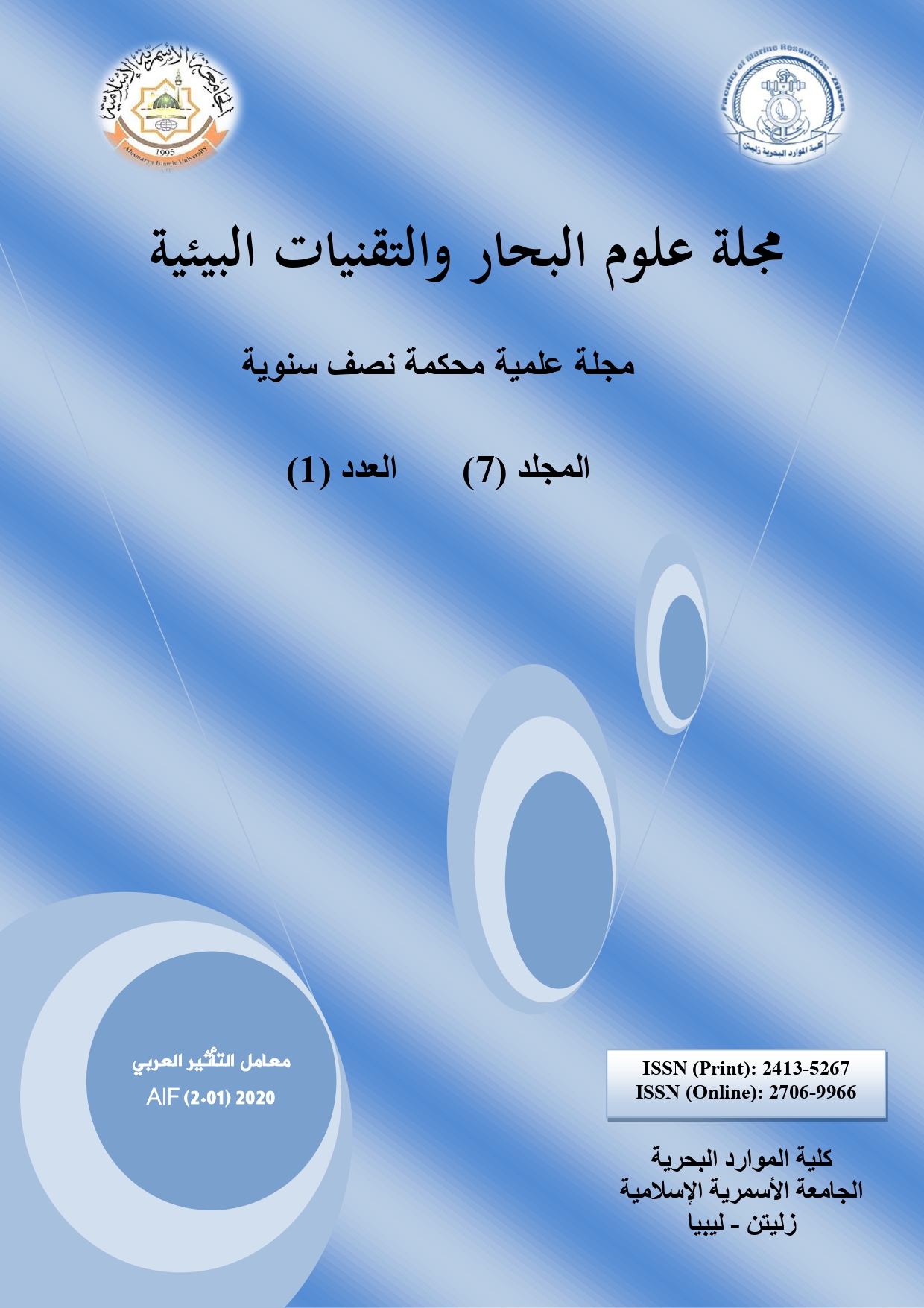دراسة لتقيم جودة مياه الآبار للمرحلة الثانية من النهر الصناعي
DOI:
https://doi.org/10.59743/jmset.v7i1.33الكلمات المفتاحية:
الحقول الشمالية والجنوبية، المرحلة الثانية، النهر الصناعي، نوعية المياهالملخص
نتيجة لعدم وجود متابعة دورية لنوعية مياه المرحلة الثانية من النهر الصناعي لتحديد خصائص جودتها في الفترة (2011-2016) كانت هذه الدراسة والتي خلصت إلى أن معدلات وتركيزات كل من درجة الحرارة, الأس الهيدروجيني, القلوية الكلية والعسورة الكلية وعناصر كل من الصوديوم والبوتاسيوم لم تتجاوز الحدود المسموح بها في كل عينات الحقول الشمالية والجنوبية وخطوط أنابيب النقل، وتبين من خلال هذه الدراسة أن معدلات جهد الأكسدة والاختزال لم تتجاوز الحدود المسموح بها كحد أعلى في معظم عينات الحقول الجنوبية (SEJH)، بينما نجدها في الحقول الشمالية (NEGH) قد تجاوزتها حيث سجل البئر رقم (019) قراءة قدرها 213mV ، وكانت معدلات تركيز البيكربونات لم تتجاوز الحدود المسموح بها في أغلب الحقول ونقاط التجميع عدا في الآبار (052-019) ونقطة التجميع (630)، حيث كانت (200.08), (202.52), (222.04) مجم/لتر على التوالي. توصلت الدراسة أيضا إلى أن معدلات تراكيز الكبريتات لم تتجاوز الحدود المسموح بها في أغلب العينات الممثلة للآبار ونقاط التجميع والخط الرئيسي ولكن تجاوزتها في بئرين وهما (368 و424) وتبين أن معدلات قراءات تراكيز الكلوريد تراوحت ما بين (213.7-497) مجم/لتر في الآبار (480 و368) على التوالي، وإنها تجاوزت الحد المسموح به في معظم العينات الممثلة للحقول والخط الرئيسي. وأظهرت نتائج اختبارات العد الاحتمالي البكتريولوجي أن جميع العينات خالية من بكتريا مجموعة القولون البرازية، وأنه لا يوجد تلوث بكتريولوجي لهذه العينات. وقد يعزى هذا التباين في تركيزات ومعدلات بعض العناصر لطبوغرافية المنطقة وطبيعة التكوين الصخري نتيجة للضخ المستمر المستنزف للمياه الجوفية.
المراجع
أولاً: المراجع باللغة العربية
السلاوي، محمد (1989). المياه الجوفية بين النظرية والتطبيق. الدار الجماهيرية للنشر والإعلان والتوزيع، مصراتة، ليبيا.
المنهراوي, سمير؛ حافظ, عزة (1997). المياه العذبة: مصادرها وجودتها. الدار العربية للنشر والتوزيع، القاهرة، مصر.
الباروني، سليمان (1995). تأثير الاستغلال المفرط للمياه الجوفية في ليبيا. مجلة الهندسي، النقابة العامة للمهن الهندسية، طرابلس.
الرابطي، عبد القادر على؛ الغويل، محمد خالد (1996). ملامح تدهور الإمداد المائي بمدينة طرابلس خلال الفترة (1977-1995). مجلة الهندسي، النقابة العامة للمهن الهندسية، طرابلس.
موسى، عبد الحكيم مسعود (1994). تقيم نوعية المياه الجوفية بحقل السواني. مجلة الهندسي، النقابة العامة للمهن الهندسية، طرابلس.
الصادق، عبد الرازق مصباح (1999). تقييم جودة المياه الجوفية بمنطقة تاجوراء بليبيا. رسالة ماجستير، كلية الزراعة جامعة الفاتح، طرابلس، ليبيا.
الغرياني، سعد احمد (1996). أزمة المياه وتواصل التنمية. الهيئة القومية للبحث العلمي، طرابلس، ليبيا.
هميلة، محمد على (1997). الموارد الطبيعية المياه والتربة في ليبيا أفاق تطويرها وترشيد استخدامها. مجلة الهندسي، النقابة العامة للمهن الهندسية، طرابلس.
حمودة، عمر سليمان (1998). سلوكيات المحافظة على المياه. مجلة الهندسي، النقابة العامة للمهن الهندسية، طرابلس.
البلعزي، خالد محمد؛ ماشينة، جمال عبد الرحمن (1996). التحلية الخيار الأمثل. مجلة الهندسي، النقابة العامة للمهن الهندسية، طرابلس.
الشاعر، محمد (1991) المياه الجوفية المالحة بحوض مرزق. مجلة الدراسات الصحراوية، المركز العربي لأبحاث الصحراء وتنمية المجتمعات، ليبيا.
ثانياً: المراجع باللغة الإنجليزية
American Public Health Association Standard Methods for Examination of water and wastewater (1975). 14 EDITION APHA Washington D.C.
Hafi Z.B. (1998). Hydrochemical evaluation of the coastal Quaternary aquifer east of Tripoli, Libya. Journal of African Earth Sciences, 26(4): 643-648.
التنزيلات
منشور
إصدار
القسم
الرخصة
الحقوق الفكرية (c) 2021 مجلة علوم البحار والتقنيات البيئية

هذا العمل مرخص بموجب Creative Commons Attribution 4.0 International License.









